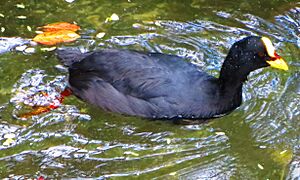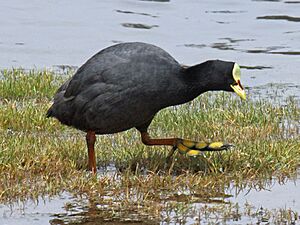Red-gartered coot facts for kids
Quick facts for kids Red-gartered coot |
|
|---|---|
 |
|
| At the Chilean National Zoo in Santiago, Chile | |
| Conservation status | |
| Scientific classification | |
| Genus: |
Fulica
|
| Species: |
armillata
|
 |
|
The red-gartered coot (Fulica armillata) is a type of bird that belongs to the family of rails, gallinules, and coots. These birds are found in several South American countries, including Argentina, Brazil, Chile, Paraguay, and Uruguay.
Contents
What Does a Red-Gartered Coot Look Like?
Red-gartered coots are medium-sized birds, growing to be about 43 to 51 centimeters (17 to 20 inches) long. Both male and female coots look very similar.
Adult coots have a bright yellow bill and a yellow shield on their forehead. There's a cool red patch right between their bill and forehead. Their legs are orange-yellow, and they have a pale red "garter" band just above their ankles, which gives them their name! Their feathers are mostly a dark gray color, looking almost black on their head and neck. The feathers under their tail are white.
Younger coots look a bit different. Immature birds have a lighter bill than adults, and their legs and feet are olive green. Baby coots, called juveniles, are a dull gray-brown with darker spots on their white head and neck.
Where Do Red-Gartered Coots Live?
Red-gartered coots live across a wide area in South America. You can find them from central and southern Chile, Paraguay, and southeastern Brazil, all the way south through Argentina to a place called Tierra del Fuego. Sometimes, they even fly as far as the Falkland Islands by accident.
These coots love to live near water. They make their homes in large ponds, lakes, rivers, and marshy areas. In winter, they might even move to calm bays along the coast. While they usually live in lower areas, they can be found in higher places too, like up to 1,200 meters (about 3,900 feet) in Patagonia and even 2,100 meters (about 6,900 feet) in parts of northwestern Argentina.
Scientists have even found very old bones of these birds, called fossils, in Chile!
How Do Red-Gartered Coots Behave?
Movement and Travel
Most red-gartered coots tend to stay in one place for their whole lives. However, they do sometimes move around locally, especially if they need to find new food or better places to live. Occasionally, they might even wander far from their usual homes.
What Do Red-Gartered Coots Eat?
Red-gartered coots mainly eat plants that grow in the water. They are good at diving deep into open water to find their food. Sometimes, in shallower water, they will tip their bodies upside down, like a duck, to reach plants on the bottom. They also like to graze on grass and other plants on land, especially near the water's edge.
Reproduction and Family Life
The breeding season for red-gartered coots changes depending on where they live, but it's usually between September and November. These birds are monogamous, meaning a male and female pair up and stay together to raise their young.
During breeding season, they can be quite protective of their territory and might act aggressive towards other birds. But when it's not breeding season, they are more social and often gather in groups.
They build a loose, platform-like nest using dried rushes. The nest usually floats on the water or is attached to reeds. A female coot can lay anywhere from two to eight eggs. Both parents work together to keep the eggs warm until they hatch, and then they both take care of the baby coots.
Sounds and Calls
Red-gartered coots make different sounds for different reasons.
- Male coots make a "whistled 'huit'" sound if they sense danger.
- When they are being aggressive, males might make an "explosive 'pit'" or a repeated "wuw" sound.
- If a male is near a female, he might make a soft, repeated "cuit."
- Female coots have an alarm call that sounds like "yec." They also make a loud, repeated "terr" sound.
Are Red-Gartered Coots in Danger?
The IUCN (International Union for Conservation of Nature) has looked at the red-gartered coot and decided it is a species of "Least Concern." This means that, for now, they are not considered to be in danger of disappearing. We don't know exactly how many red-gartered coots there are or if their numbers are changing, but no major threats have been found. They are generally thought to be a common bird.
Images for kids





